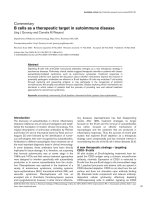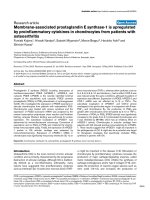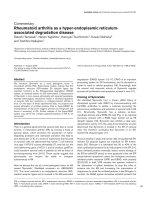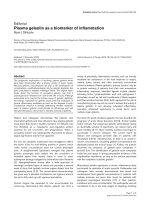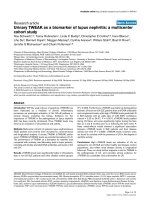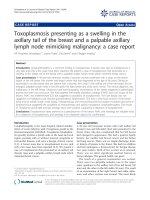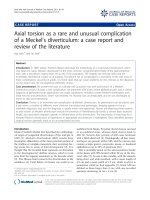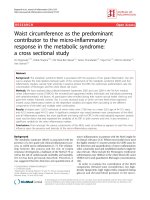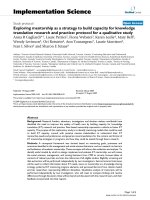Báo cáo y học: "Fluid balance as a biomarker: impact of fluid overload on outcome in critically ill patients with acute kidney injury" potx
Bạn đang xem bản rút gọn của tài liệu. Xem và tải ngay bản đầy đủ của tài liệu tại đây (44.3 KB, 3 trang )
Page 1 of 3
(page number not for citation purposes)
Available online />Abstract
Fluid therapy is fundamental to the acute resuscitation of critically
ill patients. In general, however, early and appropriate goal-directed
fluid therapy contributes to a degree of fluid overload in most if not
all patients. Recent data imply that a threshold may exist beyond
which, after acute resuscitation, additional fluid therapy may cause
harm. In patients with acute kidney injury and/or oliguria, a positive
fluid balance is almost universal. Few studies have examined the
impact of fluid balance on clinical outcomes in critically ill adults
with acute kidney injury. Payen and coworkers, in a secondary
analysis of the SOAP (Sepsis Occurrence in Acutely Ill Patients)
study, now present evidence that there is an independent
association between mortality and positive fluid balance in a cohort
of critically ill patients with acute kidney injury. In this commentary,
we discuss these findings within the context of prior literature and
propose that assessment of fluid balance should be considered as
a potentially valuable biomarker of critical illness.
Introduction
Acute kidney injury (AKI) is common [1], increasingly
encountered [2] and known to contribute to increased short-
term and long-term morbidity and mortality [1,3]. Few if any
interventions are proven to alter the clinical course and
outcome of AKI once it is established. Thus, conventional
management has been largely supportive, with a focus on
averting complications and allowing renal recovery to occur.
Clinical management surveys have found the manner of
‘supportive’ care for the critically ill patient with AKI to be
variable among practitioners [4]. Moreover, many of the
supportive therapies available, including fluid administration,
diuretic use and extracorporeal renal replacement (RRT), are
highly context specific.
Fluid therapy, in particular, is integral to the acute resusci-
tation of critically ill patients and is probably the only effective
strategy in terms of preventing AKI. Practically all patients
receive variable amounts of fluid therapy during an episode of
critical illness. There is consensus that fluids should be given
early and targeted to appropriate physiologic end-points. The
concept of early goal-direct therapy as a guide for acute
resuscitation in septic shock was considered ground
breaking [5]. Notably, in this trial, by 72 hours all enrolled
patients had received 13 to 14 l fluid therapy. No specific
data were provided on the occurrence of AKI, oliguria, or fluid
balance. However, the septic patient is known to be at high
risk for AKI, and so a high incidence was probable [6]. In this
context, AKI contributes to impaired free water and solute
excretion, and almost universally translates into fluid
accumulation. In fact, a degree of fluid overload is more the
rule than exception in the septic patient. However, a threshold
may exist beyond which the perceived benefit of additional
fluid therapy (or accumulation) after resuscitation may
contribute to harm [1,7,8].
We contend that the assessment of fluid balance should be
regarded a potentially valuable biomarker of critical illness. In
a small retrospective study of 36 patients with septic shock,
Alsous and coworkers [7] identified higher mortality in those
not achieving a negative fluid balance in at least one of the
first 3 days after intensive care unit (ICU) admission. The
impact of maintaining a neutral or negative fluid balance has
been shown to improve outcomes in acute lung injury [9] and
pulmonary oedema [10], and it is predictive of successful
weaning from mechanical ventilation [11]. In a cohort of
Commentary
Fluid balance as a biomarker: impact of fluid overload on
outcome in critically ill patients with acute kidney injury
Sean M Bagshaw
1
, Patrick D Brophy
2
, Dinna Cruz
3
and Claudio Ronco
3
1
Division of Critical Care Medicine, Faculty of Medicine and Dentistry, University of Alberta, 3C1.12 Walter C Mackenzie Centre, 8440-112 ST NW,
Edmonton, T6G 2B7, Canada
2
Division of Nephrology, Hypertension, Dialysis and Transplantation, Department of Pediatrics, 285 Newton Road, 1269-A CBRB, Iowa City, Iowa,
52242, USA
3
Department of Nephrology Dialysis & Transplantation, San Bortolo Hospital, Viale Rodolfi 37, 36100 Vicenza, Italy
Corresponding author: Claudio Ronco,
Published: 24 July 2008 Critical Care 2008, 12:169 (doi:10.1186/cc6948)
This article is online at />© 2008 BioMed Central Ltd
See related research by Payen et al., />AKI = acute kidney injury; CRRT = continuous renal replacement therapy; %FO = percentage fluid overload; ICU = intensive care unit; RRT = renal
replacement therapy.
Page 2 of 3
(page number not for citation purposes)
Critical Care Vol 12 No 4 Bagshaw et al.
septic patients with AKI, Van Biesen and colleagues [8]
showed that additional fluid therapy (despite apparent
optimal haemodynamics, restoration of intravascular volume
and a high rate of diuretic use) not only failed to improve
kidney function but also led to unnecessary fluid accumu-
lation and impaired gas exchange.
There is an abundance of small clinical studies of critically ill
children with AKI that have identified degree of fluid overload
to be an independent variable associated with mortality
[12-15]. Goldstein and coworkers [14] evaluated 21 children
with AKI and found a higher percentage fluid overload (%FO;
calculated as [(total fluid in – total fluid out)/admission body
weight × 100]) at the time of initiation of continuous RRT
(CRRT) to be associated with lower survival, independent of
severity of illness. This finding was further confirmed in two
additional investigations (one retrospective single centre
study and one prospective observational multicentre study) of
critically ill children with multiple organ dysfunction syndrome
and AKI [12,15]. In another retrospective review, Gillespie
and coworkers [13] found that %FO above 10% at CRRT
initiation was independently associated with mortality (hazard
ratio = 3.02, 95% confidence interval = 1.5 to 6.1; P = 0.002).
In recent surveillance of 51 children receiving stem cell
transplantation whose course was complicated by ICU
admission and AKI [16], CRRT was initiated in 88% for
management of fluid overload (average %FO at initiation was
12.4%). These data strongly support the view that there is a
survival benefit from early initiation of CRRT to prevent fluid
accumulation and overload in critically ill children, once initial
fluid resuscitative management has been accomplished.
Few clinical investigations, until now, have evaluated the
impact that fluid balance has on clinical outcomes in critically
ill adults with AKI [1]. In a secondary analysis of the SOAP
(Sepsis Occurrence in Acutely Ill Patients) study, Payen and
colleagues [1] examined the influence of fluid balance on
survival of critically ill patients with AKI. In this study, patients
were compared by whether they developed AKI, defined by a
renal Sequential Organ Failure Assessment score of 2 or
greater, or by urine output under 500 ml/day. Of the 3,147
patients enrolled, 1,120 (36%) developed AKI, with 75% of
episodes occurring within 2 days of ICU admission. Mortality
at 60 days was higher for those with AKI (36% versus 16%;
P < 0.01). In patients with both early and late onset AKI,
average daily fluid balance through the first 7 ICU days was
significantly more positive than in non-AKI patients (P < 0.05
for each day). Similarly, average daily fluid balance was
significantly more positive in those with oliguria (620 ml
versus 270 ml; P < 0.01) and those receiving RRT (600 ml
versus 390 ml; P < 0.001). Average daily fluid balance was
significantly higher in nonsurvivors than in survivors (1,000 ml
versus 150 ml; P < 0.001). On multivariable analysis, a
positive fluid balance (per l/24 hours) exhibited an
independent association with 60-day mortality (hazard ratio =
1.21, 95% confidence interval = 1.13 to 1.28; P < 0.001).
Although no data were available on fluid balance by timing of
RRT, those receiving earlier RRT (< 2 days after ICU
admission) had lower 60-day mortality (44.8% versus 64.6%;
P < 0.01), despite more oliguria and greater severity of
illness.
Naturally, such observational data have limitations, and the
observed associations are prone to bias from selection,
confounding and random error. However, these data, along
with those from prior studies, provide compelling evidence
that attention to fluid balance and prevention of volume
overload, in particular in AKI, may be an important and under-
appreciated determinant of survival.
These data encourage speculation that one benefit of early
RRT, when defined by the duration of time after ICU
admission (independent of the severity of AKI), may be early
prevention or control of fluid overload [17]. Moreover, this
would suggest that prevention or management of fluid
overload is evolving as a primary trigger/indicator for extra-
corporeal fluid removal, and this may be independent of dose
delivery or solute clearance. This concept is also supported
by the recent ATN (Acute Renal Failure Trial Network) trial
[18], in which patients allocated to alternate-day, less-inten-
sive haemodialysis not uncommonly had inadequate fluid
volume control necessitating additional ‘off-protocol’ ultra-
filtration sessions.
The accrued evidence implies, at least following initial
resuscitation, that attention to fluid balance has clinical
relevance. We may need a paradigm shift in how we currently
apply RRT. Rather than the conventional view as rescue
therapy (fluid overload associated with pulmonary oedema),
we must consider early RRT in order to counterbalance fluid
accumulation, particularly in those with oliguria or AKI.
Timing is crucial, and RRT should ideally be initiated as early
and safely as possible [19]. As a minimum, all critically ill
patients should have an estimate of baseline ‘dry’ weight and
determination of the iatrogenic daily and cumulative fluid load
and balance [20]. Estimation of ‘dry’ weight can be
problematic in the critically ill, and a clear priority for early
RRT in critically ill patients would be to ensure maintenance
of an adequate circulating blood volume and prevent un-
necessary complications during fluid removal. Clearly, we
need additional research to define the boundaries of fluid
balance as a biomarker of critical illness that may portend
improvements in clinical management and outcomes.
Competing interests
The author(s) declare that they have no competing interests.
References
1. Payen D, de Pont AC, Sakr Y, Spies C, Reinhart K, Vincent JL: A
positive fluid balance is associated with a worse outcome in
patients with acute renal failure. Crit Care 2008, 12:R74.
Page 3 of 3
(page number not for citation purposes)
2. Bagshaw SM, George C, Bellomo R: Changes in the incidence
and outcome for early acute kidney injury in a cohort of Aus-
tralian intensive care units. Crit Care 2007, 11:R68.
3. Hoste EA, Schurgers M: Epidemiology of acute kidney injury:
how big is the problem? Crit Care Med 2008, 36:S146-S151.
4. Ricci Z, Ronco C, D’Amico G, De Felice R, Rossi S, Bolgan I,
Bonello M, Zamperetti N, Petras D, Salvatori G, Dan M, Piccinni
P: Practice patterns in the management of acute renal failure
in the critically ill patient: an international survey. Nephrol Dial
Transplant 2006, 21:690-696.
5. Rivers E, Nguyen B, Havstad S, Ressler J, Muzzin A, Knoblich B,
Peterson E, Tomlanovich M: Early goal-directed therapy in the
treatment of severe sepsis and septic shock. N Engl J Med
2001, 345:1368-1377.
6. Bagshaw SM, George C, Bellomo R: Early acute kidney injury
and sepsis: a multicentre evaluation. Crit Care 2008, 12:R47.
7. Alsous F, Khamiees M, DeGirolamo A, Amoateng-Adjepong Y,
Manthous CA: Negative fluid balance predicts survival in
patients with septic shock: a retrospective pilot study. Chest
2000, 117:1749-1754.
8. Van Biesen W, Yegenaga I, Vanholder R, Verbeke F, Hoste E,
Colardyn F, Lameire N: Relationship between fluid status and
its management on acute renal failure (ARF) in intensive care
unit (ICU) patients with sepsis: a prospective analysis. J
Nephrol 2005, 18:54-60.
9. Wiedemann HP, Wheeler AP, Bernard GR, Thompson BT,
Hayden D, deBoisblanc B, Connors AF Jr, Hite RD, Harabin AL:
Comparison of two fluid-management strategies in acute
lung injury. N Engl J Med 2006, 354:2564-2575.
10. Mitchell JP, Schuller D, Calandrino FS, Schuster DP: Improved
outcome based on fluid management in critically ill patients
requiring pulmonary artery catheterization. Am Rev Respir Dis
1992, 145:990-998.
11. Upadya A, Tilluckdharry L, Muralidharan V, Amoateng-Adjepong Y,
Manthous CA: Fluid balance and weaning outcomes. Intensive
Care Med 2005, 31:1643-1647.
12. Foland JA, Fortenberry JD, Warshaw BL, Pettignano R, Merritt RK,
Heard ML, Rogers K, Reid C, Tanner AJ, Easley KA: Fluid over-
load before continuous hemofiltration and survival in critically
ill children: a retrospective analysis. Crit Care Med 2004, 32:
1771-1776.
13. Gillespie RS, Seidel K, Symons JM: Effect of fluid overload and
dose of replacement fluid on survival in hemofiltration. Pediatr
Nephrol 2004, 19:1394-1399.
14. Goldstein SL, Currier H, Graf C, Cosio CC, Brewer ED,
Sachdeva R: Outcome in children receiving continuous ven-
ovenous hemofiltration. Pediatrics 2001, 107:1309-1312.
15. Goldstein SL, Somers MJ, Baum MA, Symons JM, Brophy PD,
Blowey D, Bunchman TE, Baker C, Mottes T, McAfee N, Barnett J,
Morrison G, Rogers K, Fortenberry JD: Pediatric patients with
multi-organ dysfunction syndrome receiving continuous renal
replacement therapy. Kidney Int 2005, 67:653-658.
16. Flores FX, Brophy PD, Symons JM, Fortenberry JD, Chua AN,
Alexander SR, Mahan JD, Bunchman TE, Blowey D, Somers MJ,
Baum M, Hackbarth R, Chand D, McBryde K, Benfield M, Gold-
stein SL: Continuous renal replacement therapy (CRRT) after
stem cell transplantation. A report from the prospective pedi-
atric CRRT Registry Group. Pediatr Nephrol 2008, 23:625-630.
17. Bagshaw SM, Uchino S, Bellomo R, Morimatsu H, Morgera S,
Schetz M, Tan I, Bouman C, Macedo E, Gibney N, Tolwani A,
Oudemans-van Straaten HM, Ronco C, Kellum JA, for the Begin-
ning and Ending Supportive Therapy for the Kidney (BEST
Kidney) Investigators: Timing of renal replacement therapy and
clinical outcomes in critically ill patients with severe acute
kidney injury. J Crit Care 2008 [Epub ahead of print].
18. The VA/NIH Acute Renal Failure Trial Network: Intensity of renal
support in critically ill patients with acute kidney injury. N Engl
J Med 2008, 359:7-20.
19. Ronco C: Early goal directed therapy and early goal ultrafiltra-
tion therapy for critically ill patients with acute kidney injury.
Int J Artif Organs 2004, 27:911-912.
20. Ronco C: The ‘right’ weight of patients in hemodialysis: dry
you fly and wet you die or dry you’re down and wet you’re up
and around? Int J Artif Organs 2004, 27:81-82.
Available online />

